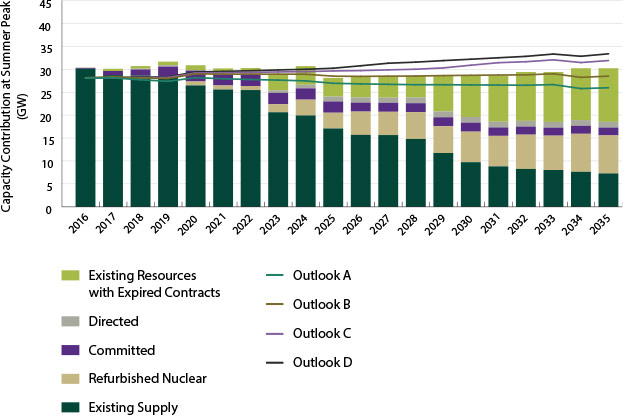At the upcoming Canadian Power Conference from the Association of Power Producers of Ontario (APPrO), thought leaders and industry representatives will discuss how new technology and public policy are disrupting Ontario’s power industry and the challenges ahead.
I will participate on a panel with George Vegh, the head of McCarthy Tétrault’s Toronto energy regulation practice, and A.J. Goulding, a Principal at London Economics International LLC. We will explore why the regulatory framework of Ontario’s electricity sector needs to change and address these key questions:
- Are the existing regulators properly structured to deal with rapid and possibly fundamental change ahead? If not, what changes are needed to ensure they can instil confidence throughout the industry?
- Does the electricity system require more robust protection against costly political intervention? If so, what mechanisms are viable in the Ontario context?; and,
- Are the road maps tabled by the existing agencies going in the right direction? Or, is a more fundamental rethink necessary?
How Ontario evolves its regulatory framework is the current focus of a panel of industry experts – the Ontario Energy Board (OEB) Modernization Review Panel. The panel was created by former premier Kathleen Wynne’s Liberal government in December 2017 and reconstituted this September by Premier Doug Ford’s Progressive Conservative government. The panel’s initial mandate included:
- Reviewing how the OEB can continue to protect consumers amidst a rapidly changing sector;
- Reviewing how it can support innovation and new technologies; and,
- Considering how the OEB should be structured and resourced to deliver on its changing role.
The Ford government narrowed the scope of the panel’s mandate, asking it to focus on the governance and operation of the OEB. It was also asked to identify immediate opportunities to restore the trust and transparency in the energy sector and promote efficiency and improved effectiveness. The panel will report back to the government on its findings and recommendations no later than January 2019. I look forward to reading its report.
The manner in which the electricity sector is regulated and governed has been scrutinized in the last few years. Several individuals, including my two co-panellists, have written critiques of the way Ontario regulates and governs the sector. Most of the criticism has been aimed at the governance of Ontario’s electricity planning process. This is the process used to identify Ontario’s future electricity needs and to make procurement decisions based on how these needs will be met, be it through generation or transmission solutions or through conservation and demand management programs.
Figure 1: Available Supply at the Time of Peak Demand Relative to Total Resource Requirements

Source: IESO. Figure 1 provides an illustration of input used in the planning process. It compares different outlooks of the systems’ peak energy demands (Outlooks A-D) to estimates of the available supply at the times of peak demand for the period 2016 to 2035. Figure 1 was taken from the 2016 Ontario Planning Outlook, a report prepared by the Independent Electricity System Operator (IESO) for the government as input into the government’s Long-Term Energy Plan.
Proposed remedies for electricity planning
The most notable critique of the province’s electricity planning process came from Ontario Auditor General Bonnie Lysyk in her 2015 report. She identified several problems with the generation and conservation procurement decisions. These included the procurement of more capacity than was needed to meet Ontario’s energy demand, overpayment for renewable energy, costly gas plant cancellations, ineffective conservation programs, and cost-ineffective conversion of the Thunder Bay coal plant to biomass.
What was the cause of these inefficient and unnecessary expenditures? According to Lysyk, “a broken down planning process.” She said the planning process operated outside the checks and balances of the legislated planning process. There was extensive use of Ministerial directives and directions for expenditures that were not subjected to a cost-benefit analysis or a statutory mandated OEB regulatory review. Lysyk provided several recommendations to the Ministry of Energy, including that there be a clarification of the roles of the IESO and Ministry of Energy in the planning process and for the Ministry to “comply with provincial legislation” and see that future electricity plans are submitted to the OEB for review and approval.
A.J. Goulding was one of the first to note concerns with the governance of the electricity planning process in a report prepared for the C.D. Howe Institute in 2013. In his report, Goulding states:
“Ontario’s electricity system operates on a framework constructed haphazardly to satisfy often-contradictory public policy goals. The result is a litany of inefficiencies.”
Goulding goes on to say that in its pursuit of “laudable” policy goals, the government has failed to implement either sound planning or rely on market principles. Consumers will pay substantially higher electricity bills over the next decade as a result. He cites generation procurement beyond what is needed to meet demand requirements (an additional cost of $370 million), an overpayment for renewables and biomass conversions, and the additional expense of gas plant cancellations as evidence of the failure to implement a planned or market approach. His proposed solution is to place greater reliance on market signals to attract new investment through the implementation of a capacity market (something the IESO is currently examining with its stakeholders), and to limit the government’s directive powers.

Thunder Bay Generation Station (source OPG). In 2015, the Ontario Auditor General noted that the newly converted biomass plant would cost $40 million per year to operate but was expected to generate only 15,000 MWh per year putting the cost of the facility at around $1,600/MWh, which is well above the cost of any other generation source. In July 2018, OPG and the IESO announced that the facility was being shuttered as it is no longer needed and is too costly to maintain.
George Vegh has written extensively on the subject of governance since the release of the Auditor General’s report (See Vegh 2016, 2017 and 2018). In his most recent comments, Vegh aligns with the views of the Auditor General and A.J. Goulding with respect to the problems with the electricity planning process. He notes there has been “a lack of oversight and good governance” in the province’s planning and procurement process that has resulted in “uneconomic, unnecessary, or ineffective” expenditures and rising costs for consumers.
Vegh identifies two possible paths forward:
- To transfer financial responsibility of the system to the provincial accounts so they can be managed like other infrastructure and social spending; or,
- To make these expenditures subject to independent review so that the OEB is given the authority to conduct cost/benefit analysis of its procurement and spending choices.
Why, when, and how to regulate
So there appears to be a consistent view with the problems of the current regulatory framework, but what is the best path forward for evolving Ontario’s regulatory framework? From my perspective, any study of the proper regulatory framework for Ontario’s electricity sector must consider three related issues:
- First, why regulate in the first place? The economic literature offers two explanations: (i) the public interest explanation, which justifies regulation as a means to correct market failures and to improve social welfare; and (ii) the public choice explanation, which recognizes that regulation is a government instrument that political parties can use to redistribute wealth in a sector from one interest group to another to win votes;
- Second, if regulation is used, when should the government delegate regulatory decision-making to an independent, unelected regulatory agency and when will it preserve the authority for itself?; and,
- Third, if the government does delegate authority, how should it prescribe this authority to a regulator?
Addressing these three issues should help to further highlight the deficiencies in the current regulatory framework with respect to the electricity planning processes and to provide a clearer picture for how to remedy these deficiencies.
In the lead up to and following the APPrO conference, I plan to write a series of blogs. My next two blogs will address the three issues I identified above as they pertain to the Ontario situation. I will use the material in these blogs to shape the views and comments that I will offer during the APPrO panel discussion. Following the conference, I will post a final blog that summarizes my views and those expressed by my co-panellists at the conference.
I am looking forward to the APPrO discussion, but until then, it is time for me to work through my thoughts and prepare my talking points. I hope to add some useful insights to an already complex and challenging discussion.
